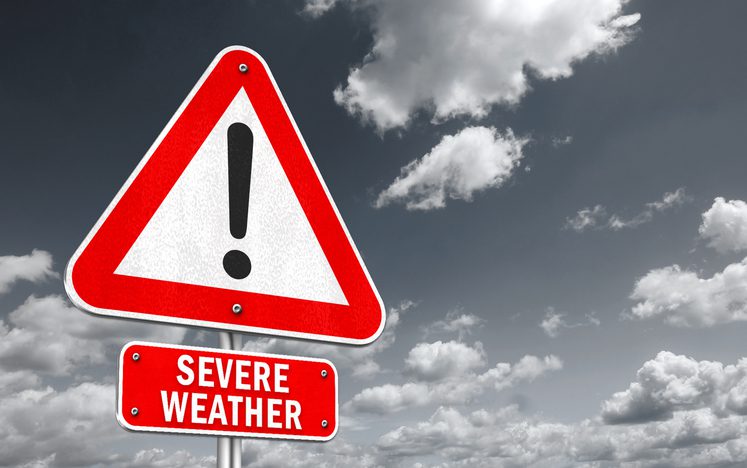Flooding causes billions of dollars in damage to U.S. homes every year. And floods can strike in many ways—from flash floods to hurricane storm surges to broken levees to snowmelt.
In fact, “floods are the most common and widespread of all weather-related natural disasters,” according to the National Severe Storms Laboratory.
The Financial Toll of Floods
For homeowners, the costs of cleaning up after a flood can be enormous—especially if they don’t have flood insurance. Six inches of flooding in a 2,500-square-foot home can cause nearly $53,000 worth of damage, according to estimates from FEMA. But the total can run much higher than that depending on individual circumstances. This can include the area’s real estate values, what property was actually damaged and replacement costs.
And you don’t have to live along the Mississippi river or near a coastline to experience a flood. Although most people think of flooding as river overflow, some may not realize that surface water – whether from a heavy thunderstorm, clogged storm drains or even broken water mains—can also be considered a flood. This is typically not covered in a standard homeowners insurance policy. Separate flood insurance, usually available through the federal government, is required to cover this exposure.
Thankfully, there are ways to help minimize the risk of flood damage to your home, if you act early enough. Here are some tips:
1. Inspect your Drainage System
Flooding can cause both exterior and interior damage to your home, and faulty water drainage is often the culprit. To rectify, begin regularly clearing your gutters of debris. Check the gutter system for any gaps or leaks that may be directing water toward the foundation of your home, rather than away from it.
Downspout extensions should divert water at least four feet away from the foundation, and the soil within 3 feet of the home should slope away from it. If you discover a slope problem, a contractor can regrade your yard to ensure water flows in the right direction.
2. Check Your Foundation and Windows
Water can seep into your home through cracks in the foundation, so inspect it and fill any cracks with the right preventive materials. Also consider sealing the outside of the foundation. Repairing large foundation cracks may require the help of a structural engineer or basement specialist.
Basement and low-level window wells are also areas that may allow water to seep into the home. Buy a window well cover that fastens securely to help prevent water from spilling into the well.
3. Prevent Sewer Backups
Sewer line backups can cause costly—and gross—flooding in homes. And whether your insurance covers it or you have to bear the brunt of the cost on your own will depend on the source of the water.
For example, if water flows into your home from overflowing storm sewers, this is generally considered a flood and some of the cost may be covered on a flood insurance policy. However, if there is a clog in your house lines and your own sewage backs up, some of the cost may be covered on your homeowners policy.
Thankfully, there are ways to help prevent sewage backups. One of the cheapest and most effective steps you can take is installing a backflow preventer in the main line to the sewer. This can reduce your exposure to a sewer main backup.
A professional sewer line inspection and cleaning, which usually costs less than $150, can unclog your sewer line and identify any blockages. Mature tree roots, for example, can penetrate or crush a home’s sewer line and cause a major backup into your home’s basement. Therefore, it’s important to identify such issues before they become huge problems.
Also be sure to avoid putting things down your home’s pipes that could lead to a clog or backup. This includes cooking grease or large food scraps.
4. Have a Sump Pump—and Test It Regularly
A sump pump removes water that has collected in a basin on a below-ground-level area of the home, such as a basement or crawlspace. It can help prevent mold and mildew from growing, which can be an expensive consequence of water and flood damage.
Though not always an inexpensive installation, a sump pump can prevent thousands of dollars of flood damage—so it can be worth it in homes prone to flooding. Keep in mind that you may need two or three sump pumps depending on your flooding risks.
If you have a sump pump, be sure to inspect and test it regularly to ensure that it’s working properly. A common way to test it is to pour a small bucket of water into the basin to see whether your sump pump automatically kicks on to remove the water.
Remember that a sump pump only works if your home has power. So you will need a backup power source, such as a sump-pump battery or a home generator, to help ensure that water will still be pumped out of your home even if a storm or flood cuts off power to your area.
5. Move Valuables and Appliances to High Ground
Elevation is your best defense against flooding. Keep any treasured or high-value possessions above ground, such as on the upper level of your home or on the top shelves of closets and cupboards. Avoid storing objects on the floor, especially in basements or other ground-level areas.
Put any appliances, such as washing machines and dryers, on wood or cement blocks so they sit at least a foot off the ground. And be sure to make copies of all of your important documents, which you secure in a fire-safe, waterproof box kept in a high-level location. It helps to know how high floodwaters can rise in your area.
The Federal Emergency Management Agency (FEMA) offers online flood maps that identify flooding risks for a particular address.
6. Turn Off the Electricity When Flooding Seems Likely
During or after a flood, your home’s electrical system may pose a shock risk, which could seriously harm people or damage objects. To prevent such damage, first ensure that you’re not at risk for shocking yourself. Then, turn off electricity to any parts of your home that are likely to experience flooding by shutting off breakers or unscrewing fuses. And do not walk in floodwater.
“If floodwaters are getting close to the electrical entrance box, call the power supplier and have the electrical supply to the house disconnected,” advises Kenneth Hellevang, an extension engineer for North Dakota State University.
The Best Defense: Preparation
Take steps to prevent flood damage long before floodwaters start spilling into your home. Put together a flood preparation checklist and evacuation plan and make sure everyone has a copy.
This article contains only general descriptions of coverages which may be provided and does not include all of the features, exclusions, and conditions of the policies it describes. Certain coverages, features, and credits vary by state and may not be available to all insureds. You should consult the actual policy language and speak with the appropriate representative to resolve any questions. In the event of a loss, the terms of the policy(ies) issued will determine the coverage provided.








Does Hartford Insurance offer service line protection in their Homeowners Policy and if not why not?
Hi Donald – Please give us a call at 800-423-0567 and one of our representatives would be happy to review homeowners insurance coverages with you. Thanks for reading Extra Mile!
A dehumidifier makes a world of difference when it comes to mold and moisture.
The chances of flooding here are not zero but pretty minimal. So I’m not eager to spend any significant money on flood insurance.
I’m in a retirement community, so am only responsible for my own belongings here. You have me for that.
Let me know if you disagree and why.
Thanks.
Hi Ann – For questions on flood insurance, please give us a call at 888-413-8970. One of our specialists would be happy to review coverage options with you. Thanks for reading Extra Mile!
I didn’t realize that water seeping into your home’s foundations could be cause for larger damage. I definitely notice that there are a few cracks around the base of my home that water seeps through after a storm. I have no clue where the water goes but if it’s as bad as you say then I’m a bit worried. I’ll do what I can to patch them up, but next time a storm runs through here, I’ll make sure to hire a flood damage mitigation service just to be safe.
I’m new to your blog and i really appreciate the nice posts and great layout.`.`-,
Oh my goodness! a tremendous article dude. Thanks Nevertheless I’m experiencing difficulty with ur rss . Don’t know why Unable to subscribe to it. Is there anybody getting an identical rss problem? Anyone who is aware of kindly respond. Thnkx
Emerald – Thanks! You can sign up for the Extra Mile newsletter here.